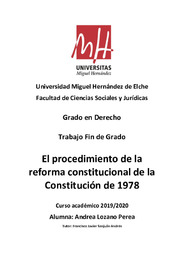Please use this identifier to cite or link to this item:
https://hdl.handle.net/11000/8293El procedimiento de la reforma constitucional de la Constitución de 1978
| Title: El procedimiento de la reforma constitucional de la Constitución de 1978 |
| Authors: Lozano Perea, Andrea |
| Tutor: Sanjuán Andrés, Francisco Javier |
| Editor: Universidad Miguel Hernández de Elche |
| Department: Departamentos de la UMH::Ciencia Jurídica |
| Issue Date: 2020-02 |
| URI: http://hdl.handle.net/11000/8293 |
| Abstract: El presente Trabajo Fin de Grado muestra como la reforma constitucional es un aspecto importante que nos encontramos en todas y cada una de las constituciones de la actualidad. Como veremos más adelante, es muy difícil que una Constitución perdure inalterable para siempre, ya que las sociedades cambian y, con ellas, todos los aspectos que la conforman -leyes, ideales, formas de vivir, problemas, etc-. Sin embargo, no todas tienen las mismas facilidades a la hora de ser reformadas, ya que nos encontramos ante constituciones flexibles y constituciones rígidas. Que una constitución sea rígida no implica que sea extremadamente irreformable, sino que requiere de unos procedimientos más complejos y de mayorías más amplias, necesitando así un mayor consenso para su reforma. La Constitución Española de 1978 es una Constitución de las denominadas rígidas, cuya reforma se encuentra regulada en los artículos 167 y 168 de la misma. Veremospor qué nuestra Constitución es una de las menos reformadas comparada con diferentes constituciones europeas, mostrando así su rigidez -o la incapacidad de los gobernantes para realizar reformas-. Y decimos incapacidad de los gobernantes porque, aunque no se ha tratado en el presente trabajo, numerosas han sido las propuestas de reforma constitucional que los partidos políticos han efectuado en cada una de las numerosas campañas electorales habidas hasta la fecha, pero que se han quedado ahí. Así, nos centraremos en la reforma constitucional que plantea la Constitución Española de 1978 y el procedimiento completo llevado a cabo en las dos reformas realizadas -más bien por “obligación”. Finalmente, realizaremos una comparación con el procedimiento de reforma de diferentes constituciones europeas -Alemania, Francia y Reino Unido- y la de Estados Unidos, mostrando así las facilidades o dificultades que tiene cada una de ellas para realizar una reforma constitucional. This Final Year Dissertation explainswhy the matter of Constitutional Amendment is so important in everysingle Constitution allover the world. As we will see further on,it is natural for all societies to undergo a series of transformations over time whichlead to subsequentchanges in their laws, ideals, ways of living, problems, etc.,thus making itvery difficult for a Constitution to remain unchanged for ever.However, some Constitutions can be more easily amendedthan othersdepending on which group they belong to: the so-called Flexible Constitutions are easier to change than the so-called Rigid Constitutions.But being a Rigid Constitution type does not imply that it cannot be amended at all. It simply means thata series of more complex procedures must be followed and that wider majorities, thus wider consensus,must be reached before the amendment can be passed. The Spanish Constitution of 1978 belongs tothe Rigid type andits amendment is provided in articles 167 and 168. We will be able to understand why our Constitution is one of the least amended oneswhencompared to other European Constitutions, thus showing its rigidity – or the rulers’ lack of capacity to undertake any change -. And we say “lack of capacity” by the rulersbecausea high number of constitutional amendments have been proposed by political parties of different ideologies during the numerous electoral campaigns to date, but inmost cases they have just failed to pass the amendments. We will,therefore, focus on the constitutional amendment which is provided for by the Spanish Constitution of 1978.We will also explain the full procedure carried out beforeeffectively passing the two amendments that, although mainly “forced by circumstances”, have nevertheless been accomplished: historical background, processing, referendum, approval, promulgation and publication. Finally, we will compare the amendment proceedings of the Spanish Constitution to those of some European constitutions – Germany, France and United Kingdom - as well as to that of the USA, and we will evidence either how easy or how difficult it isfor each of themto pass a constitutional amendment. |
| Keywords/Subjects: reforma constitucional constitutional amendment constitución Constitución Española procedimiento mayoría artículo constitution Spanish Constitution proceedings majority article |
| Knowledge area: CDU: Ciencias sociales:Derecho: |
| Type of document: application/pdf |
| Access rights: info:eu-repo/semantics/openAccess |
| Appears in Collections: TFG- Derecho |
.png)

